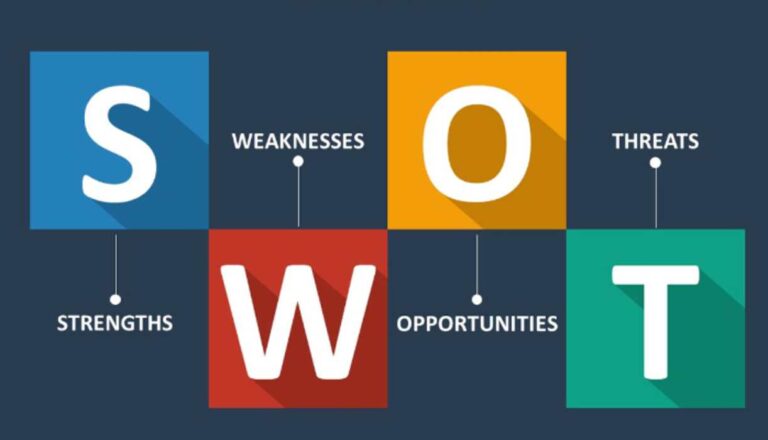How to do a SWOT analysis

Perhaps you don’t know;
The word SWOT stands for Strength, Weakness, Opportunity, and Threat. Swot analysis can therefore be defined as a technique for organizing or documenting a business’s internal strengths, and weaknesses, as well as identifying external opportunities and threats.
Strengths and weaknesses are those things that happen internally such as patents, brand reputation, etc while opportunities and threats are from external sources like competitors, price, etc.
SWOT analysis is therefore essential in every business, it helps business owners to understand the state of the market and how to use it to their advantage.
In the following, you’ll see how you can do a SWOT analysis of your business and take your business ahead of its competitors.
SWOT Analysis: a breakdown
SWOT analysis is a broad term when it comes to business and marketing. Here is a breakdown of what each of these elements connotes.
S – Strength
Strength is an element used to describe the company’s greatest achievement and what can be used to win their clients’ hearts. It encompasses all the things the company or brand has ever done well. Strength could be
- Those things that make your brand perform excellently.
- Attributes that differentiate your brands from your competitors.
- Internal resources such as skilled personnel, and excellent products.
- Tangible assets such as capital, intellectual properties, and proprietary technologies.
W – Weakness
Weakness refers to those things that are capable of delaying a company’s growth. It involves analyzing a brand’s challenges and several ways these challenges can affect the business’s existence. Weaknesses could be
- Qualities you don’t have.
- Areas where your competitors outsmart you.
- Ambiguous selling position.
- Limited resources.
O – Opportunity
Opportunity is an external element. It talks about those innovative Ideas you can introduce into your business at a particular time that will produce high sales.
It could also be an opportunity to generate new customers by communicating frequently with existing customers. Opportunities could also be
- Fewer competitors in your niche.
- Increase in demand for your products or services.
- Press or media coverage of your brand.
T – Threat
Threat is the last element in the SWOT analysis. It refers to those things that can serve as hindrances to your brand’s growth and survival.
The threat is also anything that poses risk to your brand’s success. Other things that could pose a risk to business growth include
- Increase in competitors
- Negative media coverage
- Changes in customers’ attitude to your products.
- Changing regulatory environment.
Steps to conduct a swot analysis
The following are the necessary steps to follow to conduct a successful SWOT analysis for your business:
1. Identify the objective of your SWOT analysis
Before conducting a SWOT analysis, it’s very important to have an objective in mind. Ensure you have what you intend to achieve with the analysis.
It might also be to answer a question that needs urgent answers in your business. For instance, you can conduct a SWOT analysis to determine whether to change your marketing techniques or not.
2. Research your business, market, and industry
Take your time to research your business, who your target audience is, what they want, your market, the niche you want to dominate, and the industry you find yourself in.
You can do this by communicating with your staff, customers, partners, and shareholders.
3. Highlight your business strengths
The next step in conducting a successful SWOT analysis is to identify and list your business strengths. Look into what you see as your company’s biggest achievements and reviews that can put your business in the face of your customer.
It’s also important to know those things that make you superior to your competitors or the best qualities that serve as an advantage for you.
Not only your company’s great review but look into other internal factors that can put you at an advantage. Examples could include strengths relating to financial growth, business location, competitiveness, cost advantage, etc.
However, a definitive list of any ideas and thoughts is encouraged.
4. Highlight your business weaknesses
Identifying and listing your business weaknesses is the next step. It’s important to know those things you think are not good for your business growth.
Know those things that put your brand at disadvantage to others and the qualities your competitors possess that make them different from you. Examples of weaknesses could be not having new products or services, staff absenteeism, declining market share, and lack of intellectual properties.
Ensure that you address the issues brought up in your SWOT analysis. The list of flaws can show how your company has developed over time.
You might find that your weaknesses have been addressed when you review the SWOT analysis a year after. Even though you might discover new flaws, the fact that the old ones are gone indicates that you’ve made progress.
5. Highlight potential opportunities in your business
Potential opportunities are not the same as your business strength. List all the external opportunities that can make your business flourish among the competitors.
Note that an opportunity sometimes could turn out to be a threat.
For instance, if you introduce a new product to draw the attention of customers and unknowingly to you, your competitors already have the products. This could turn out to be a threat to your business.
In that case, that is no longer an opportunity but a new threat to your business.
Perfect opportunities in business could be a new partnership, new technology and innovation, training programs, and change in government.
6. List the threat to your business
Identify and list the potential threats to your business or know those things that can affect your brand’s productivity.
It could be unemployment, increased competition, uncertainty in the global market, etc.
7. Draw an inference from the elements
After you have listed each element (SWOT) and how they can affect your business, the next is to draw a valid inference from it.
Have a detailed description of the current state of your business and the problems that need to be addressed.
8. Develop a strategy to tackle the issues in the Swot analysis
Plot out the best strategies to use to:
- dominate your niche
- put your strength to good use
- overcome weaknesses and fill up all loopholes
- use your business’s strengths to overcome the threats
- make use of the opportunities.
And then you’re done. In all, ensure you take your time to devise and execute your plan.
Conclusion
SWOT analysis is a great tool for determining the strength, weaknesses, opportunities, and threats of a business. It helps business owners know more about their industry and market and deploy the right strategies to keep them above the competition and also increase sales.
If you want to evaluate your brand’s progress and productivity, SWOT analysis is the most preferred technique.
Don't miss a thing. Follow us on Telegram and Follow us on WhatsApp. If you love videos then also Subscribe to our YouTube Channel. We are on Twitter as MakeMoneyDotNG.





